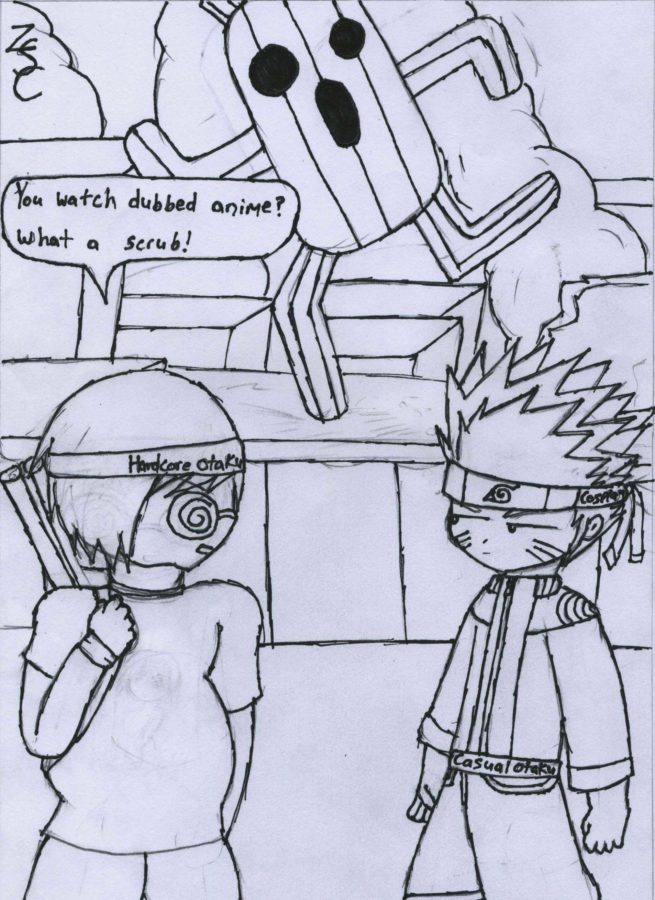I have been a fan of anime for years, gone to anime conventions and been in anime clubs where the golden rule is to watch with subtitles only.
It’s easier to multitask during dubbed anime because you can listen to it. I’m a busy guy with work and school. I don’t have much free time. In short, I multitask. I’m an auditory learner, and I learn the most if the information is spoken. If there is complete silence in the background, it’s as distracting as a room full of people. I do homework or write short stories with a video or music in the background. I sometimes go on Netflix to find anime, like “Blue Exorcist,” and it’s sub only. I’m about halfway though it, but I have to set aside time so I can follow what’s happening on screen and read the text at the same time.
I normally set subs on for everything, even in my own language, just in case someone is speaking too softly. So if you’re like me–limited free time and need to cram it into other tasks or just need something in the background–it doesn’t work to have subtitles.
I don’t like to pirate dubs either. I support the people who make the products, and I get them through legit streaming sites.
My mother, a court interpreter, told me a number of times that “there is more to translating then just making a sentence from Spanish to English or from English to Spanish.” She’s right; part of her job isn’t direct translation but a localized one, like “stuck between a rock and a hard place” becomes “stuck between the wall and the blade” in Spanish. Some subs are pretty bad from cheap localizing companies with staff that may or may not have lied about how much they know about Japanese.
Translation is a very difficult skill to learn. Not only do you have to learn a whole new language from scratch, but you have to understand the culture around the language; the slang, slurs, the different formal and informal pronouns. Translating English to Spanish is hard to do, notable differences being five vowel sounds in Spanish compared to the 30 plus English has. English has more gender neutral terms than Spanish, where everything has a gender.
Japanese to English and back is a completely different story. Japanese has no Latin roots–its closest cousins are Korean and Mandarin. Writing Japanese goes up and down instead of left to right, and a lot of their words have no real meaning in English. Nothing in our language relates to it. For example, there are eight ways to say “hi” in Japanese. I use hi because that’s the roughest translation to it.
Dubs are also an art form. Being able to take a medium from one language to another takes a lot of work. One must transfer the scripts, and do it in a way that syncs with what’s on screen. Most animation from Japan has minimal facial expressions so it’s easier to sync up.
There is a good amount of fan-translated subs and dubs out there that put production studios to shame, but I don’t feel the same appreciation than the subs production studio. Better yet, fans’ dubs only had to translate from scratch with minimal funding, and a number of abridged dubs are featured on YouTube. Many have fan bases like Yu-Gi-Oh Abridged.
There’s only three real big production studios left–Bandai, Funimation and Viz. Dubs like “Trigun,” “Dragon Ball” and “Dragon Ball Z” have a lot of great voice actors who aren’t in the industry anymore.
Dubs are usually the same couple of actors doing the same roles over and over again, which does get annoying. The rest moved on to other things because lack of opportunities and the thankless nature of dubbing. Other criticisms are that it loses the original meaning if it’s dubbed.
Well guess what? The fact you’re reading subs on screen means the original meaning is already lost. The act of translation is to reform the way it makes sense in the other language. The original message is mostly there at best, but at worst, it’s only a reflection of the original meaning. So subs still kill the original meaning, it’s just less noticeable than dubs.




